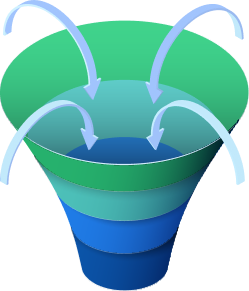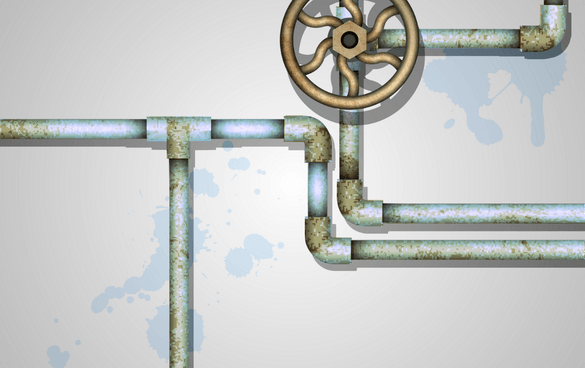-
 Published: Mar 16, 2023
Published: Mar 16, 2023
-
 6 min. read
6 min. read
-
 Matthew Gibbons
Matthew Gibbons Lead Data & Tech Writer
Lead Data & Tech Writer
- Matthew is a marketing expert focusing on the SEO & martech spaces. He has written over 500 marketing guides and video scripts for the WebFX YouTube channel. When he’s not striving to put out some fresh blog posts and articles, he’s usually fueling his Tolkien obsession or working on miscellaneous creative projects.
A sales pipeline analysis is where you study your sales pipeline to find what’s going on with your leads. We’ll explain more below, including why you should conduct a sales pipeline analysis and six of the best sales pipeline metrics to track. Read on to learn more!
If you find that you’re not driving as many sales as you’d like — or even if you are — it pays to perform a sales pipeline analysis to figure out how you can improve it. But what is a sales pipeline analysis, and why do you need it?
Keep reading to find out more. Also, check out this video about sales funnels:
Then subscribe to Revenue Weekly, our email newsletter, for more digital marketing tips from the experts!
Join 200,000 smart marketers and get the month’s hottest marketing news and insights delivered straight to your inbox! “*” indicates required fields (Don’t worry, we’ll never share your information!)Don’t miss our Marketing Manager Insider emails!
Enter your email below:
Inline Subscription Form – CTA 72

What is sales pipeline analysis?
Sales pipeline analysis is the process of examining your sales pipeline to figure out what’s happening with your leads and why.
What does sales pipeline analysis tell you?
Sales pipeline analysis helps you learn valuable info about your leads. For the leads that convert, what convinces them to do so? For the ones that don’t, what drives them away? And of the two, which happens more often?
The exact way you conduct your analysis is entirely up to you, but it’s usually helpful to look at various key performance indicators (KPIs) to help you see what kind of results you’re driving.
Why conduct sales pipeline analysis?
The reason for conducting a sales analysis is simple — it helps you learn how to improve your sales process. It shows you what you’re doing well, allowing you to better repeat those successes down the road. Likewise, it shows you the weak spots in your sales, like where you’re losing leads.
By taking the information you get from your sales pipeline metrics and using it to revise your sales process as a whole, you can steadily increase the number of sales you drive, earning you a higher return on investment (ROI) over time.
Bonus Read: What Is a Sales Pipeline and Why Do You Need It To Drive Revenue?
6 sales pipeline metrics to track and analyze
We’ve mentioned a couple of times now that one of the best ways to conduct a sales analysis is to track different pipeline KPIs, but what KPIs are those?
Here are six sales pipeline metrics to analyze.
1. Conversion rate per stage
Your conversion rate simply refers to what percentage of your leads convert. Of course, the word “convert” can mean different things. In earlier stages of the sales funnel, it might simply mean signing up for your email list. But at the end of the pipeline, it means making a purchase.
That’s why you should track your conversion rate separately for each stage of the pipeline. That lets you identify where you’re losing the most leads. If you have a high conversion rate at the end of the pipeline, but a low one at the beginning, that tells you it’s your top-of-funnel sales process that needs work.
2. Sales cycle duration
Your sales cycle duration is a measure of how long the average sales cycle lasts — that is, how long it takes for the average customer to travel from the beginning of the pipeline to the end.
The longer someone spends in the pipeline, the greater the chance of them dropping out before making a sale. Plus, the longer it takes for leads to progress through the pipeline, the slower your revenue will flow.
3. Sales pipeline velocity
Sales pipeline velocity is closely tied to sales cycle duration. Rather than measuring how long leads stay in the pipeline, though, it measures how quickly revenue flows through it.
To calculate it, multiply the number of deals currently in your pipeline by the size of an average deal, and then divide by your average sales cycle duration.
This metric is helpful for the same reason as sales cycle duration — it tells you how fast and efficient your sales pipeline is at delivering revenue to you.
4. Customer acquisition cost (CAC)
Customer acquisition cost (CAC) is a measurement of how much it costs, on average, to earn a new customer. To calculate your CAC metric, add up your total marketing and sales costs during a given period and then divide by your total number of new customers during that period.
This gives you a feel for how much you’re spending on your sales pipeline. If your CAC is obnoxiously high, it means either you’re vastly overspending or your sales efforts are driving very poor results. Either way, you’ll want to work on balancing that ratio in your favor.
5. Churn rate
Another metric to watch out for is churn rate. Churn rate is basically a measure of what percentage of your leads and customers you lose in a given period. To calculate it, divide the number of customers lost by the number of customers you started that period with, and then multiply by 100.
It likely goes without saying, but the higher your churn rate, the worse off you are. A high churn rate tells you that something at the middle or end of your pipeline is driving away people you initially managed to attract, so your job then is to find out what that is.
6. Net promoter score (NPS)
Net promoter score (NPS) is a customer satisfaction metric. It simply measures how pleased your customers are with your business. To find your NPS, survey your customers on how likely they are to recommend your business on a scale of 1 to 10.
A high NPS indicates that customers are very satisfied with your company, but a low one shows a lot of room for improvement. If your NPS isn’t where you want it to be, make sure you also ask your customers what they think you can do to improve. Then implement those improvements to increase your NPS.
Pro tip: Want to know your NPS? Use our free NPS calculator to find out your net promoter score in just a few seconds!
Learn how to patch it with our free tool.A hole in your marketing funnel will drain your sales.


WebFX can help you optimize your sales pipeline analysis
If you’re struggling to find and fix gaps in your sales funnel, it can quickly become an overwhelming task — like fixing your sink, it can become a situation where every time you fix a leak, you spring a new one. That’s why you can benefit from getting some help from sales and marketing experts like WebFX.
We have over 28 years of experience with digital marketing and sales, and we know exactly what it takes to drive more sales and revenue. With our digital marketing services, we can help you vastly improve the quality of your funnel.
To get started with us, just call 888-601-5359 or contact us online today!
-
 Matthew is a marketing expert focusing on the SEO & martech spaces. He has written over 500 marketing guides and video scripts for the WebFX YouTube channel. When he’s not striving to put out some fresh blog posts and articles, he’s usually fueling his Tolkien obsession or working on miscellaneous creative projects.
Matthew is a marketing expert focusing on the SEO & martech spaces. He has written over 500 marketing guides and video scripts for the WebFX YouTube channel. When he’s not striving to put out some fresh blog posts and articles, he’s usually fueling his Tolkien obsession or working on miscellaneous creative projects. -

WebFX is a full-service marketing agency with 1,100+ client reviews and a 4.9-star rating on Clutch! Find out how our expert team and revenue-accelerating tech can drive results for you! Learn more
Try our free Marketing Calculator
Craft a tailored online marketing strategy! Utilize our free Internet marketing calculator for a custom plan based on your location, reach, timeframe, and budget.
Plan Your Marketing Budget
Table of Contents
- What is Sales Pipeline Analysis?
- What Does Sales Pipeline Analysis Tell You?
- Why Conduct Sales Pipeline Analysis?
- 6 Sales Pipeline Metrics to Track and Analyze
- 1. Conversion Rate Per Stage
- 2. Sales Cycle Duration
- 3. Sales Pipeline Velocity
- 4. Customer Acquisition Cost (CAC)
- 5. Churn Rate
- 6. Net Promoter Score (NPS)
- WebFX Can Help You Optimize Your Sales Pipeline Analysis

Maximize Your Marketing ROI
Claim your free eBook packed with proven strategies to boost your marketing efforts.
Get the GuideTry our free Marketing Calculator
Craft a tailored online marketing strategy! Utilize our free Internet marketing calculator for a custom plan based on your location, reach, timeframe, and budget.
Plan Your Marketing Budget





